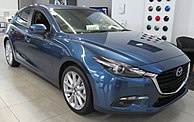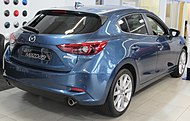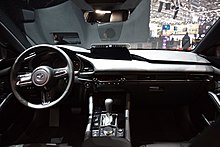Mazda3
| Mazda3 | |
|---|---|
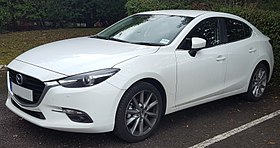 | |
| Overview | |
| Manufacturer | Mazda |
| Also called | Mazda Axela (Japan and China) |
| Production | 2003[1]–present |
| Body and chassis | |
| Class | Compact car |
| Body style | |
| Layout | Front-engine, front-wheel-drive or four-wheel-drive[2] |
| Platform | Mazda B |
| Chronology | |
| Predecessor | Mazda Familia |
The Mazda3 or Mazda 3 (known as the Mazda Axela in Japan, a combination of "accelerate" and "excellent"[3]) is a compact car manufactured in Japan by Mazda. It was introduced in 2003 as a 2004 model, replacing the Familia/323/Protegé in the C-segment. A performance-oriented version of the Mazda3 is marketed as the Mazdaspeed3 in North America, Mazdaspeed Axela in Japan and the Mazda3 MPS in Europe.
A second generation Mazda3 for the 2009 model year was unveiled in late 2008, with the sedan premièring at the Los Angeles Auto Show and the hatchback at the Bologna Motor Show. For the 2012 model year, Mazda began offering the Mazda3 with their newly-developed SkyActiv technology, including a more rigid body, a new direct-injection engine, and a new 6-speed transmission.[4]
The third generation was introduced in mid-2013 as a 2014 model.
A fourth generation all-new Mazda3 for the 2019 model year was unveiled in November 2018 at the Los Angeles Auto Show and the ASEAN premiere at the Singapore Motor Show. For the 2019 model, the all-new Mazda3 is equipped with the newly-developed SkyActiv technology, including the latest Skyactiv-X, Skyactiv-G and Skyactiv-D engines, each of which provides responsive speed control in any driving situation, and a Spark-Controlled Compression Ignition system.[5][6]
The Mazda 3 became Mazda's fastest-selling vehicle in January 2019, with cumulative sales of over 6-million units.[5]
First generation (BK; 2003–2008)[edit]
| First generation (BK) | |
|---|---|
_Neo_sedan_(2010-06-10).jpg) | |
| Overview | |
| Production |
|
| Assembly |
|
| Designer | Hasip Girgin (2001)[14] |
| Body and chassis | |
| Platform | Mazda BK |
| Related | |
| Powertrain | |
| Engine | |
| Transmission | |
| Dimensions | |
| Wheelbase | 2,639 mm (104 in) |
| Length | 2004–06 i Sedan: 4,529 mm (178 in) 2004–06 s Sedan: 4,540 mm (179 in) 2004–06 Hatchback: 4,485 mm (177 in) 2007–09 i Sedan: 4,506 mm (177 in) 2007–09 s Sedan: 4,511 mm (178 in) 2007–09 Hatchback: 4,591 mm (181 in) |
| Width | 1,750 mm (69 in) |
| Height | 1,500 mm (59 in) |
| Curb weight | 1,340 kg (2,954 lb) |
The BK series Mazda3 was launched in Japan in October 2003 as the Axela. The model has been generally well received by the automotive press for its performance, handling, styling and interior, with some describing it as feeling like a more expensive sports sedan/saloon despite its value-oriented price.[15] Some criticisms have included fuel economy and crash test results (only receiving four out of a maximum five stars from the EURO NCAP Safety Testing Programme) the latter of which was rectified by making six airbags standard.[16][17] In 2006 the Mazda3 was the second best-selling car in Canada and the best selling car in Israel during 2005–2007.[18][19]
Design[edit]
The Mazda3 is based on the Ford global C1 platform, shared with the latest European Ford Focus and Volvo S40. Previewed by the MX-Sportif concept car, the Mazda3 is available in two body styles, a four-door fastback sedan/saloon, marketed as a "4-door coupé style" in Europe, and a five-door hatchback, branded the Sport version in Canada, Japan, and the United States. Design work began under chief designer Hideki Suzuki in 1999 at three Mazda design centres in California, United States; Frankfurt, Germany; and Hiroshima, Japan. By 2001, Hasip Girgin's design was chosen as a finalist. Girgin was sent to work in Hiroshima for 6 months, after which the final design was frozen for scheduled 2003 production.
The front suspension comprises MacPherson struts, with coil springs and an anti-roll bar. The rear suspension is a Ford-designed "E-link" multi-link suspension, with four locating links per wheel and an anti-roll bar, suspended on coil springs that are mounted inboard of the shock absorbers to reduce suspension intrusion into the cargo area. Four-wheel Disc brakes are fitted, with 300 mm (11.8 in) discs in the front and 279 mm (11 in) discs in the rear; ABS and electronic brake force distribution are available or standard, depending on the model. Wheel and tire sizes vary with model, from 15" on base models to optional 17" wheels on upper-level models. The Mazda3 was used as a regular police patrol car by the Public Security Police Force of Macau alongside the Toyota Corolla and the Honda Civic police cars in Macau, China.
When first introduced, United States-market Mazda3 models were available in only two trim levels, i and s, with the 2.0 L and 2.3 L engines, respectively. Since then Mazda has introduced additional models under the Touring and Grand Touring labels. British Mazda3s are offered in S, TS, TS2, Sport, and a top end 2.3 L turbocharged Mazda3 MPS (Mazda Performance Series) models. Since April 2008, when there was a mainly cosmetic facelift of the Mazda3, there have been some changes to the trim designations for UK cars, with the models now being the entry-level S, then Takara (which replaces TS & TS2), the Tamara Special Edition and the Sport and MPS as before.
All three models use the inline-4 Mazda MZR engine, with various types, displacements and outputs including the MZ-CD turbodiesel, depending on model and market. Transmissions are a five-speed manual transmission and a four-speed automatic transmission; since the 2006 model year, a five-speed automatic is optional on models with the 2.3 L engine. This transmission has now been made standard on the 2.0 L engine in Japan (FWD models only), as part of a minor facelift in early 2008 which includes different front/rear bumper designs, new wheel designs and body colors, stiffened chassis, and better interior materials. The MPS / Mazdaspeed version is only available with a six-speed manual.
Engines[edit]
The Mazda3 features the following engines:
Japanese market (JIS ratings):
- 1.5 L: 118 PS (87 kW), 140 N⋅m (103 lb⋅ft)
- 2.0 L: 150 PS (110 kW), 183 N⋅m (135 lb⋅ft)
- 2.3 L: 171 PS (126 kW), 214 N⋅m (158 lb⋅ft)
European market (ECE ratings):
- 1.4 L: 84 PS (62 kW), 122 N⋅m (90 lb⋅ft)
- 1.6 L: 105 PS (77 kW), 145 N⋅m (107 lb⋅ft)
- 2.0 L: 150 PS (110 kW), 187 N⋅m (138 lb⋅ft)
- 2.3 L MZR DISI Turbo: 260 PS (191 kW), 380 N⋅m (280 lb⋅ft)
- 1.6 L MZ-CD common-rail diesel: 109 PS (80 kW), 240 N⋅m (177 lb⋅ft)
- 2.0 L MZR-CD common-rail diesel: 143 PS (105 kW), 360 N⋅m (266 lb⋅ft)
- 2.2 L MZR-CD common-rail diesel: 185 PS (136 kW), 400 N⋅m (295 lb⋅ft)
American & Canadian markets (SAE net ratings):
- 2.0 L: 148 bhp (110 kW), 135 lbf·ft (183 N·m) (04–05) PZEV engine: 145 bhp (107 kW) (04–06), 144 bhp (107 kW) (07–); 132 lbf·ft (179 N·m) (all years)
- 2.3 L: 160 bhp (119 kW), 150 lbf·ft (203 N·m) PZEV engine: 153 bhp (113 kW), 149 lbf·ft (202 N·m) (2006 only)
- 2.3 L MZR DISI Turbo: Mazdaspeed3: 263 bhp (196 kW), 280 lbf·ft (380 N·m)
Mazda changed the rating for US & Canadian markets 2007 2.3 L naturally aspirated engine:
- 2.3 L: 160 bhp (119 kW), 150 lbf·ft (203 N·m) PZEV engine: 151 bhp (113 kW), 149 lbf·ft (202 N·m) (07–)
Asian markets (DIN ratings):
- 1.6 L: 110 bhp (78 kW), 107 lbf·ft (145 N·m)
- 2.0 L: 148 bhp (110 kW) and 138 lbf·ft (187 N·m)
Australian market (ADR net ratings):
- 2.0 L: 145 bhp (108 kW), 134 lbf·ft (182 N·m)
- 2.3 L: 154 bhp (115 kW), 150 lbf·ft (203 N·m)
- 2.3 L: DISI MZR: 260 bhp (190 kW), 280 lbf·ft (380 N·m)
- 2.0 L MZR-CD common-rail diesel: 143 PS (105 kW), 360 N⋅m (266 lb⋅ft)
South African market (DIN net ratings):
- 1.6 L: 109 bhp (77 kW), 108 lbf·ft (146 N·m)
- 2.0 L: 140 bhp (104 kW), 134 lbf·ft (182 N·m)
- 2.3 L: 154 bhp (115 kW), 150 lbf·ft (203 N·m)
- 2.3 L: DISI MZR: 260 bhp (190 kW), 280 lbf·ft (380 N·m)
Performance[edit]
Official performance figures for the European Mazda3 1.4 S, the lowest-powered model, are 0–100 km/h (62 mph) in 14.3 seconds, with a maximum speed of 170 km/h (106 mph). Wheels magazine reported an 8.7-second 0–100 km/h time for the Australian 2.0 model in its May 2004 issue.
The 1.6 CiTD 80 kW diesel (as sold in Europe) with a five-speed manual does 0–100 km/h (62 mph) in 11.6 seconds and has a top speed of 182 km/h (113 mph) according to the official Mazda specifications.
In test results for the 2012 Mazda 3 Maxx Sport five-door 2.0-litre engine, it has been reported as having a 0–100 km/h (62 mph) acceleration time of 9.2 seconds and a top speed of 190 km/h (120 mph).
In its test results for the 2004 Mazda3 five-door with the 2.3-litre engine, Car and Driver magazine reported a 0–60 mph (0–97 km/h) acceleration time of 7.4 seconds and a governor-limited top speed of 190 km/h (118 mph).
Car and Driver documented the acceleration of a 2007 Mazda3 four-door sedan. Equipped with a 2.3 liter engine and 5-speed manual transmission, the Mazda3 has a 0-60 mph (97 km/h) time of 7.3 seconds and completes the quarter mile in 15.8 seconds at 88 mph (142 km/h).[20]
The fuel consumption of these models averages in the 10 L/100 km (24 mpg‑US; 28 mpg‑imp), with the 2-litre 2008 Mazda3 automatic-transmission model scoring a 10 L/100 km (24 mpg‑US; 28 mpg‑imp)/7.6 L/100 km (31 mpg‑US; 37 mpg‑imp) city/highway United States Environmental Protection Agency (EPA) rating.
2006[edit]
For the 2006 model year, Mazda added variable valve timing and variable-length intake runners to the 2.0-liter engine resulting in a power increase to 150 bhp (112 kW; 152 PS). The automatic transmission used in the S trim Mazda3 with the 2.3-liter engine was changed from a four-speed to a five-speed design. The larger engine was now PZEV-certified (Partial Zero Emissions Vehicle) for vehicles sold in California and other states that have adopted California automotive emission standards. The smaller engine had already been PZEV-certified. The colour palette was also simplified in 2006, with the deletion of Canary Yellow and Lava Orange Mica.[21][22]
2007[edit]
The 3 received a minor cosmetic facelift for the 2007 model year with minimal exterior, interior and mechanical changes. On base models, the black plastic at the top of the grille became body-coloured. The front fascia and bumper were changed with a floating foglight design and the lower air intake opening was reshaped to better resemble the typical "Mazda five-point face." All Mazda3 sedans and five-doors gained the same "Axela" clear-lens style rear tail-lights as the SP23 model, which in 2007, Mazda brought out the Mazda Axela similar to the Mazda6 Atenza. In addition, the Grand Touring trim also featured LED brake lights. The LED brake lights were added to compete with the growing trend of higher-end vehicles using LED tail lamps for more visible light output. The range of alloy wheels were redesigned, featuring a 17-inch alloy wheel for the Grand Touring version. The rear fascia was slightly changed adding a notch on the bumper cover of the sedan. Several new exterior colors were added, phantom blue, a copper red metallic (April, 2008), Aurora Blue and dark cherry. The Titanium Gray color was replaced with a darker Galaxy Gray color.[22]
The interior of the Mazda3 was offered with several new color choices and an audio jack in the centre console, allowing the use of digital music players. Also, Takara models, which were introduced in the 2008 upgrade, added climate control and 6-CD autochanger to the TS specification.[22]
The 2007 model also includes less visible mechanical changes. The keyless entry system was improved. Reinforcements to the body shell improve overall chassis rigidity. The front dampers of the MacPherson strut suspension have been re-tuned to quicken steering response and reduce understeer. The hydraulic dampers of the multi-link rear suspension were also re-tuned to match the front suspension changes. Mazda engineers and designers addressed concerns regarding cabin noise level by redesigning or changing multiple systems and adding sound-deadening material to the roof lining and hood panel.[22]
The bumper-to-bumper warranty was reduced to 36 months / 36,000 miles while the powertrain warranty was increased to 60 months / 60,000 miles in most markets. In the UK, all Mazda3s have a 3-year unlimited mileage warranty, 3-year roadside assistance and 12 year anti perforation warranty as standard.[23][22]
Canadian Mazda3s received standard seat-mounted side-airbags and body-shell-mounted side-curtain airbags across the model range. Previously, both airbag types were not available.[22]
2008[edit]
An additional trim level included the Sport GX with a 2.0 L engine, previously all Sport hatchbacks had a 2.3 L engine and came only in GS or GT trims. Compared to the GX sedan, the GX hatchback has body-coloured door handles, and fog lamps. Options for the Sport GX include air conditioning, a convenience package containing power accessories and 15-inch alloys, and a rear trunk spoiler.[22]
The GS sedan received standard 16-inch alloy wheels, previously only available with the moonroof option, while the GX had 15-inch alloy wheels added to the convenience package (which includes steering-wheel mounted audio controls, power windows, power locks, and remote entry). The GS hatchback now comes with factory-installed air conditioning. GT models received standard xenon headlights, previously part of the leather package.[22]
In the U.S., the i Touring trim level was replaced by the i Touring Value model. This new model added a body-color front grille, fog lights and 17" alloy wheels, giving it a very similar appearance to the more expensive s models. The interior also received leather-covered steering wheel and shift knob from the s model. Anti-lock brakes and side-impact airbags, previously optional, were now standard.[22]
2009[edit]
Initial news reports indicated the 2009 model year would receive a minor facelift by the end of the year with exterior design modifications that included chrome door handles, a new roof spoiler, expanded use of black moldings on the rear bumper, and new alloy-wheel options.[24] This turned out to not occur in the US or Canadian market. The 2009 model year was only a few months long as production ceased in November 2008.[18][22]
Australia[edit]
In Australia, The BK 3 replaced the (BJ) 323 in January 2004. The original irretiration came in several guises, "Neo", "Maxx", "Maxx Sport" & "SP23". The base "Neo" guise came with remote central locking, a four speaker sound system with a CD Player among other features. Building upon the Neo, the "Maxx" offered power windows and mirrors, alloy wheels, remote keyless central locking, six speakers and an in-dash sound system. The "Maxx Sport" added primarily cosmetic features, with that including a body kit, front fog lamps and larger alloy wheels. The "SP23" gained a larger engine as well as other smaller luxury features.[25]
In July 2006, Mazda introduced its Series II 3. Updates included refreshed front and rear light fixtures, as well updated alloy wheels and a new fog light configuration. A high performance "MPS" Hatch was introduced into the lineup within this update.[26]
The 3 continuously sold well throughout The BK generation, with it reaching 4th in Australian sales within 2006. The following table lists its sales made throughout its tenancy.
| Year | Yearly Sales | Total |
|---|---|---|
| 2004 | 22,046 | 166,615 |
| 2005 | 32,570 | |
| 2006 | 32,432 | |
| 2007 | 34,394 | |
| 2008 | 33,755 | |
| 2009 (Jan-Apr) | 11,418 |
Second generation (BL; 2010–2013)[edit]
| Second generation (BL) | |
|---|---|
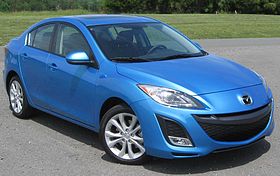 Mazda3 S Grand Touring (USA) | |
| Overview | |
| Production | November 2008—June 2013[27] 2010- (Iran) |
| Assembly | |
| Designer | Kunihiko Kurisu (2006)[30] |
| Body and chassis | |
| Platform | Mazda BL |
| Related | |
| Powertrain | |
| Engine | |
| Transmission | |
| Dimensions | |
| Wheelbase | 2,640 mm (103.9 in) |
| Length | 4,595 mm (180.9 in) (Sedan) 4,505 mm (177.4 in) (Hatchback) |
| Width | 1,755 mm (69.1 in) |
| Height | 1,470 mm (57.9 in) |
| Curb weight | 1,260 kg (2,777.8 lb) |
In development from 2004 and designed under Kunihiko Kurisu from early 2005 to August 2006, in November 2008 Mazda debuted the second generation Mazda3 with restyled exterior. Two engines were offered in the US and Canadian markets, the 2.0 L petrol engine offered in the previous generation and a new 2.5L inline-4 shared with the second-generation Mazda6.[31]
The C1 architecture, a collaboration of Ford, Mazda, and Volvo,[32] is carried over from the previous generation[33] though marginally wider, longer and lighter than the previous generation. The 2.3L engine was replaced with a 2.5L engine that produces 167 bhp (125 kW; 169 PS) and 167 lb⋅ft (226 N⋅m) of torque. In other markets, more engines are offered including a new 2.2 L turbodiesel engine.[34] A 2010 Mazda3 with a 2.5 L engine and 6-speed manual transmission accelerates from 0-60 mph (97 km/h) in 7.4 seconds and completes the quarter mile in 15.7 seconds at 87 mph (140 km/h).[35]
Mazda unveiled the 2010 Mazda3 sedan/saloon at the Los Angeles Auto Show on 19 November 2008. The new Mazda3 is slightly larger than the older Mazda3 and is available in "i" and "s" versions. The "i" (GX or GS in Canada) is powered by a 148 bhp (110 kW) 2.0L engine while the "s" (GT in Canada) is powered by a 167 bhp (125 kW) 2.5L engine adapted from the Mazda6.[36] Both engines are also available in PZEV versions in the US, the 2.0 L producing 144 bhp (107 kW) and the 2.5 L producing 165 bhp (123 kW).[37] The 3s Grand Touring trim level adds leather seats, power driver's seat, rain-sensing windshield wipers, dual-zone automatic climate control, and steerable active bi-xenon headlights as standard equipment.[36] The hatchback was unveiled a few weeks after the sedan/saloon at the Bologna Motor Show.
The European model includes a start-stop system with the 2.0L DISI engine with an estimated increase fuel economy in city cycle by roughly 12%.[38]
Midway through 2010, features including side mirrors with integrated turn signals, footwell lighting, and power seat memory functions were removed.[citation needed]
Mazdaspeed 3[edit]
Full details and images of the high-powered Mazdaspeed3 (a.k.a. Mazda3 MPS) were released at the Geneva Motor Show in March 2009.[39] Like the previous generation, the Mazda3 hatchback variant has been selected as the basis for the 2nd generation Mazdaspeed3.
2012 update[edit]
The 2012 Mazda3 with SkyActiv powertrain was unveiled at the Canadian International Auto Show in Toronto, February 2011. It comes with Mazda's SkyActiv-G 2.0-liter, direct-injection gasoline engine, and SkyActiv-Drive 6-speed automatic or SkyActiv-MT 6-speed manual transmission.[40] There are minor exterior updates: revised grille and air intakes, and a reshaped rear valance panel. Skyactiv models receive a blue ring around the projectors in the headlamps.[41] Car and Driver reported that such a Mazda3 can reach estimated EPA fuel-economy ratings of 30 mpg city and 39 to 40 highway.[42]
Engines[edit]
| Model | Type | Power, torque@rpm | CO2 emissions (g/km) |
|---|---|---|---|
| Japanese models | |||
| ZY-VE | 1,498 cc (91.4 cu in) I4 | 111 PS (82 kW; 109 hp)@6000, 140 N⋅m (100 lb⋅ft)@4500 | |
| LF-VDS | 1,999 cc (122.0 cu in) I4 | 150 PS (110 kW; 150 hp)@6200, 186 N⋅m (137 lb⋅ft)@4500 | |
| LF-VE | 1,999 cc (122.0 cu in) I4 | 143 PS (105 kW; 141 hp)@6500, 179 N⋅m (132 lb⋅ft)@4000 | |
| L3-VDT | 2,261 cc (138.0 cu in) I4 turbo | 264 PS (194 kW; 260 hp)@5500, 380 N⋅m (280 lb⋅ft)@3000 | |
| European models | |||
| 1.6 dohc | 1,598 cc (97.5 cu in) I4 | 105 PS (77 kW; 104 hp)@6000, 145 N⋅m (107 lb⋅ft)@4000 | 149 |
| 2.0 dohc w/ AT | 1,999 cc (122.0 cu in) I4 | 150 PS (110 kW; 150 hp)@6500, 187 N⋅m (138 lb⋅ft)@4000 | 175 |
| 2.0 dohc DISI w/i-stop | 1,999 cc (122.0 cu in) I4 | 151 PS (111 kW; 149 hp)@6200, 191 N⋅m (141 lb⋅ft)@4500 | 159 |
| MPS dohc DISI | 2,261 cc (138.0 cu in) I4 turbo | 260 PS (190 kW; 260 hp)@5500, 380 N⋅m (280 lb⋅ft)@3000 | 224 |
| 1.6 8V sohc | 1,560 cc (95 cu in) I4 diesel | 116 PS (85 kW; 114 hp)@3600, 270 N⋅m (200 lb⋅ft)@1750–2500 | 114 |
| 2.2 dohc | 2,184 cc (133.3 cu in) I4 diesel | 150 PS (110 kW; 150 hp)@3500, 360 N⋅m (270 lb⋅ft)@1800 | 144 |
| 2.2 dohc | 2,184 cc (133.3 cu in) I4 diesel | 185 PS (136 kW; 182 hp)@3500, 400 N⋅m (300 lb⋅ft)@1800 | 149 |
| US models | |||
| 4-door i | 1,999 cc (122.0 cu in) I4 | 150 PS (110 kW; 150 hp)@6500, 183 N⋅m (135 lb⋅ft)@4500 | |
| SKYACTIV-G 2.0 | 1,999 cc (122.0 cu in) I4 | 157 PS (115 kW; 155 hp)@6000, 201 N⋅m (148 lb⋅ft)@4100 | |
| 4-door i PZEV | 1,999 cc (122.0 cu in) I4 | 146 PS (107 kW; 144 hp)@6500, 179 N⋅m (132 lb⋅ft)@4500 | |
| 4-door s | 2,488 cc (151.8 cu in) I4 | 169 PS (124 kW; 167 hp)@6000, 228 N⋅m (168 lb⋅ft)@4000 | |
| 4-door s PZEV | 2,488 cc (151.8 cu in) I4 | 167 PS (123 kW; 165 hp)@6000, 226 N⋅m (167 lb⋅ft)@4000 | |
| 5-door s | 2,488 cc (151.8 cu in) I4 | 169 PS (124 kW; 167 hp)@6000, 227 N⋅m (167 lb⋅ft)@4000 | |
| MAZDASPEED3 | 2,261 cc (138.0 cu in) I4 turbo | 267 PS (196 kW; 263 hp)@5500, 380 N⋅m (280 lb⋅ft)@3000 | |
| Canadian models | |||
| 4-door GX, GS | 1,999 cc (122.0 cu in) I4 | 150 PS (110 kW; 150 hp)@6500, 183 N⋅m (135 lb⋅ft)@4500 | |
| 4-door GT | 2,488 cc (151.8 cu in) I4 | 169 PS (124 kW; 167 hp)@6000, 228 N⋅m (168 lb⋅ft)@4000 | |
| 5-door GX | 1,999 cc (122.0 cu in) I4 | 150 PS (110 kW; 150 hp)@6500, 183 N⋅m (135 lb⋅ft)@4500 | |
| 5-door GS, GT | 2,488 cc (151.8 cu in) I4 | 169 PS (124 kW; 167 hp)@6000, 227 N⋅m (167 lb⋅ft)@4000 | |
| 5-door GS-SKY | 1,999 cc (122.0 cu in) I4 | 157 PS (115 kW; 155 hp)@6000, 201 N⋅m (148 lb⋅ft)@4100 | |
| MAZDASPEED3 | 2,261 cc (138.0 cu in) I4 turbo | 267 PS (196 kW; 263 hp)@5500, 380 N⋅m (280 lb⋅ft)@3000 | |
| Australian models | |||
| Neo/Maxx (Sport) | 1,999 cc (122.0 cu in) I4 | 150 PS (110 kW; 150 hp)@6500, 183 N⋅m (135 lb⋅ft)@4500 | |
| SP20 (2012) | 1,999 cc (122.0 cu in) I4 | 155 PS (114 kW; 153 hp)@6000, 194 N⋅m (143 lb⋅ft)@4100 | |
| Diesel | 2,183 cc (133.2 cu in) I4 | 150 PS (110 kW; 150 hp)@3500, 360 N⋅m (270 lb⋅ft)@1800–3000 | |
| SP25 | 2,488 cc (151.8 cu in) I4 | 169 PS (124 kW; 167 hp)@6000, 228 N⋅m (168 lb⋅ft)@4000 | |
| MPS | 2,261 cc (138.0 cu in) I4 turbo | 259 PS (190 kW; 255 hp)@5500, 380 N⋅m (280 lb⋅ft)@3000 | |
Third generation (BM, BN; 2013–2018)[edit]
| Third generation (BM/BN) | |
|---|---|
_Neo_sedan_(2015-06-27)_01_(cropped).jpg) | |
| Overview | |
| Production | June 2013–2018 |
| Assembly |
|
| Designer | Koichi Tabata (2011) |
| Body and chassis | |
| Related | Mazda CX-5 (KF) |
| Powertrain | |
| Engine |
|
| Transmission |
|
| Dimensions | |
| Wheelbase | 2,700 mm (106.3 in) |
| Length | 4,460 mm (175.6 in) (Hatchback) 4,580 mm (180.3 in) (Sedan) |
| Width | 1,795 mm (70.7 in) |
| Height | 1,455 mm (57.3 in) |
| Curb weight | 1,300–1,315 kg (2,866–2,899 lb) |
The third generation 2014 Mazda3 was revealed in Australia on 26 June 2013.[44] It now sits atop the new Skyactiv chassis, no longer sharing the Ford C1 platform.[45] It is the third vehicle to sport the Mazda's 'KODO: Soul of Motion' design language, after the CX-5 and the Mazda6.
It has a drag coefficient (Cd) of 0.26 for the sedan/saloon, slightly higher for the hatchback.[46] Combined with the SkyActiv technology, this produces a rating from the U.S. EPA of 30 mpg‑US (36 mpg‑imp; 7.8 L/100 km) city and 41 mpg‑US (49 mpg‑imp; 5.7 L/100 km) highway for the 2 litre sedan, and one less mpg highway for the 5-door hatchback.[47]
Two SkyActiv engines are offered in North American markets, the 2.0l (with 155 hp (116 kW) and 150 lb⋅ft (200 N⋅m) of torque) and the 2.5l (with 184 hp and 185 lb-ft of torque). The 2014 Mazda3 equipped with a 2.5 litre engine and 6-speed automatic transmission accelerates from 0-60 mph (97 km/h) in 6.9 seconds and finishes the quarter mile in 15.2 seconds at 95 mph (153 km/h).[48]
The 2.0 litre engine accelerates from 0-60 mph (97 km/h) in 7.8 seconds and finishes the quarter-mile in 16.1 seconds.[49] Initially the 6-speed manual gearbox was only for the 2.0 litre cars, and automatic transmission was standard on the 2.5, or available for the 2.0. In its first-drive review of the 2014 Mazda 3, the auto enthusiast weblog Jalopnik stated that "once the 2.5 comes with a manual transmission, there is really no reason to buy anything else in this class."[50]
For the 2015 model year, the 2.5 litre cars are also offered with manual gearbox. Model grades for the U.S. market are SV (2.0 Sedan only), Sport (2.0 Sedan & Hatchback), Touring, and Grand Touring (available in all body styles with either engine). The 2014 model ranked number one among Affordable Small Cars in U.S. News & World Report's rankings.[51] In the 2014 Canadian Car of the Year rankings Mazda 3 was chosen as the Best New Small Car.[52] Canadian magazine The Car Guide chose Mazda 3 as the Best Compact Car in its Best Buys car rankings for 2015 and 2016.[53]
In Europe, three Skyactiv-G (gasoline) engines are offered, one 1.5l and two 2.0l (at two different power ratings, 120 hp (89 kW) and 165 hp (123 kW)); and a 2.2l Skyactiv-D (Diesel) engine is available. Availability of hatchback and sedan/saloon body styles and their combinations with engines varies amongst European markets. In 2014, the Mazda3 made it to the finals of the European Car of the Year competition. For the UK market, the Mazda3 Sedan is marketed as a fastback.
Thailand models of Mazda3 went on sale in 18 March 2014.[54][55]
In the UK, Mazda registered the BM model as a "BL" model, as can be seen on the V5c DVLA (Driver & Vehicle Licensing Agency) Registration Document.
A concept version of the Mazda3, with an engine powered by compressed natural gas, was unveiled in 2013 at the Tokyo Motor Show.[56][57][58][59]
In Malaysia, the third generation Mazda3 was first launched in March 2014 fully imported from Japan and was available with a sole 2.0l sedan variant.[60] In April 2015, locally assembled versions of the Mazda3 became available for purchase.[61] In April 2017, the facelift version was launch where Sedan GL, Sedan High and Hatchback was the 3 variants offered.[62]
Mazda3 SKYACTIV-Hybrid[edit]
The Mazda3 SKYACTIV-Hybrid is a version of the Mazda3 with SKYACTIV-G 2.0 engine with 14:1 compression and electric-petrol drive.
The vehicle was unveiled at the 2013 Tokyo Motor Show.[56][57]
Production[edit]
Taiwan models of the Mazda3 were produced by Ford Lio Ho Motor Co., Ltd.[63][64]
Production of the US market Mazda3 sedan at Mazda de Mexico Vehicle Operation (MMVO) in Salamanca, Guanajuato began on 7 January 2014, as the factory's first production vehicle model.[65][66]
As of 22 January 2014, cumulative production of the Mazda3 production reached four million units since June, 2003.[67][68]
Production of Thailand market Mazda3 at AutoAlliance (Thailand) Co., Ltd. (AAT) began on 14 March 2014.[54][55] Within months of release, the 3 was the 15th best-selling car in Thailand.
| Model | Type | Power, torque@rpm | CO2 emissions (g/km) |
|---|---|---|---|
| European models | |||
| G100 | 1,496 cc (91.3 cu in) I4 | 100 PS (74 kW; 99 hp), 150 N⋅m (110 lb⋅ft)@4000 | 119 |
| G120 | 1,998 cc (121.9 cu in) I4 | 120 PS (88 kW; 120 hp), 210 N⋅m (150 lb⋅ft)@4000 | 119 |
| G120 AT | 1,998 cc (121.9 cu in) I4 | 120 PS (88 kW; 120 hp), 210 N⋅m (150 lb⋅ft)@4000 | 129 |
| G165 | 1,998 cc (121.9 cu in) I4 | 165 PS (121 kW; 163 hp), 210 N⋅m (150 lb⋅ft)@4000 | 135 |
| CD150 | 2,191 cc (133.7 cu in) I4 diesel | 150 PS (110 kW; 150 hp), 380 N⋅m (280 lb⋅ft)@1800 | 107 |
| CD150 AT | 2,191 cc (133.7 cu in) I4 diesel | 150 PS (110 kW; 150 hp), 380 N⋅m (280 lb⋅ft)@1800 | 127 |
| Australian models | |||
| Neo, Maxx, Touring | 1,998 cc (121.9 cu in) I4 | 114 kW (153 hp), 200 N⋅m (150 lb⋅ft)@4000 | N/A |
| SP25, SP25 GT, Astina | 2,488 cc (151.8 cu in) I4 | 137 kW (184 hp), 251 N⋅m (185 lb⋅ft)@3250 | N/A |
| Astina diesel | 2,191 cc (133.7 cu in) I4 diesel | 129 kW (173 hp), 420 N⋅m (310 lb⋅ft)@2000 | N/A |
| American models | |||
| i SV (2014-2015), i Sport, i Touring, i Grand Touring | 1,998 cc (121.9 cu in) I4 | 155 hp (116 kW)@6000, 150 lb⋅ft (200 N⋅m)@4000 | N/A |
| s Touring, s Grand Touring | 2,488 cc (151.8 cu in) I4 | 184 hp (137 kW)@5700, 185 lb⋅ft (251 N⋅m)@3250 | N/A |
| Canadian models | |||
| GX, GS. SE & 50th Anniversary edition (Limited production) | 1,998 cc (121.9 cu in) I4 | 155 hp (116 kW)@6000, 150 lb⋅ft (200 N⋅m)@4000 | N/A |
| GT | 2,488 cc (151.8 cu in) I4 | 184 hp (137 kW)@5700, 185 lb⋅ft (251 N⋅m)@3250 | N/A |
A facelift of the Mazda 3 (BM) in August 2016 has changed its codename to Mazda 3 (BN). Changes include a new dashboard layout, new front and rear exterior styling (the latter, only in the hatchback), new first-of-its-kind G-Vectoring Control and diesel option was dropped. Safety and driver assistance features were also improved, adding a traffic sign-recognition sensor[69] and pedestrian detection with the pre-collision braking system.[70]
Fourth generation (BP; 2019–present)[edit]
| Fourth generation | |
|---|---|
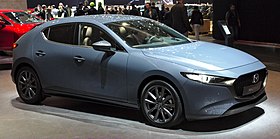 | |
| Overview | |
| Production | 2019–present |
| Designer | Yasutake Tsuchida |
| Body and chassis | |
| Related | Mazda CX-30[71] |
| Powertrain | |
| Engine |
|
| Transmission |
|
The 2019 Mazda3 hatchback and sedan were both unveiled at the 2018 Los Angeles Auto Show on November 28, 2018. They both have an improved KODO Design language based on the Vision concept cars; particularly the Kai Concept.[72][73]
Engine and transmission[edit]
The 2019 Mazda3 will feature their new spark-controlled compression ignition engine, called the SkyActiv-X. The 1.5-, 2.0- and 2.5-liter versions of the current SkyActiv gasoline engine line will also be offered, as well as the 1.8-liter SkyActiv-D diesel engine. Transmission options consist of the 6-speed SkyActiv-MT manual and the SkyActiv-Drive automatic.[73]
Motorsports[edit]
- The Mazda3 was introduced to the Speed World Challenge in 2009.
- Team Sahlen entered a Mazda3 in the Continental Tire Sports Car Challenge Street Tuner class in 2010.[74]
- Mazda South Africa, in conjunction with MFC (a vehicle finance house) entered two Mazda3 MPS models into Class-T of the South African Production Car Championship from 2007 to 2010
- Mazda3 is used in the seed category NASCAR Stock V6 Series in Mexico.[75]
Sales[edit]
| Calendar year | US[76][77] | Canada[78] | Australia | Thailand[79] |
|---|---|---|---|---|
| 2003 | 2,081 | |||
| 2004 | 76,080 | 22,046 | ||
| 2005 | 97,388 | 32,570 | ||
| 2006 | 94,438 | 32,432 | ||
| 2007 | 120,291 | 34,394 | ||
| 2008 | 109,957 | 33,755 | ||
| 2009 | 96,466 | 46,943 | 35,298 | |
| 2010 | 106,353 | 47,740 | 39,003 | |
| 2011 | 102,417 | 37,224 | 41,429 | |
| 2012 | 123,361 | 39,295 | 44,128 | |
| 2013 | 104,713 | 40,466 | 42,082 | |
| 2014 | 104,985 | 40,974 | 43,313 | 8,937 |
| 2015 | 107,884 | 34,811 | 38,644 | 7,143 |
| 2016 | 95,567 | 27,689 | 36,107 | 4,121 |
| 2017 | 75,018 | 27,862 | 32,690 | 4,979 |
| 2018 | 64,638 | 26,728 | 31,065 | 5,255 |
References[edit]
- ^ "Mazda begins production of fourth new generation product". media.ford.com. Archived from the original on 23 January 2013. Retrieved 26 May 2012.
- ^ "Mazda 3[Axela] Japanese product page". Archived from the original on 17 May 2013. Retrieved 30 March 2013.
- ^ "「アクセラ」が教習車に選ばれる理由とは?!その秘密にせまります! - 【MAZDA】マツダ公式ブログ (Mazda Japan naming inspiration)". Zoom-Zoom Blog.
- ^ "Mazda Launches Second SkyActiv Model". mazda.com. 27 September 2011. Retrieved 28 September 2012.
- ^ Jump up to: a b "Mazda Reveals All-New Mazda3". mazda.com. 28 November 2018. Retrieved 8 February 2019.
- ^ "The All-New Mazda3 Marks A New Era For Mazda". eurokarsgroup.com. 10 January 2019. Retrieved 8 February 2019.
- ^ "Mazda3 Starts Second Generation: Company spiffs up its best seller for LA Auto Show". www.oncars.com. Retrieved 25 November 2013.
- ^ "Major production facilities in Japan". Archived from the original on 29 December 2010. Retrieved 5 January 2011.
- ^ "Facilities | Ford Motor Company Newsroom". Media.ford.com. Retrieved 6 December 2010.
- ^ "Mazda3经典款". Mazda3sedan.com.cn. Retrieved 6 December 2010.
- ^ Jump up to: a b c d "Major production facilities overseas". Retrieved 5 January 2011.
- ^ "Bahman Group". Bahman Group. Archived from the original on 6 December 2010. Retrieved 6 December 2010.
- ^ Sarne, Vernon (27 June 2012). "Ford makes 'business decision' to stop manufacturing cars in PH". Top Gear Philippines. Retrieved 3 June 2013.
- ^ "gatetoturkey.com". gatetoturkey.com.
- ^ "Edmunds.com Mazda3 2009 review". Retrieved 6 March 2010.
- ^ "AutoWeek review". Retrieved 26 March 2008.
- ^ "U.S. News & World Report Best Cars & Trucks ranking". Retrieved 26 March 2008.
- ^ Jump up to: a b 2009 Mazda MAZDA3 Review by Cars.com
- ^ "Used 2008 Mazda 3 Review & Ratings - Edmunds". Edmunds.
- ^ "The Quickest Cars of 2007: Less than $20,000". Car and Driver. Hearst Corporation. Retrieved 25 June 2014.
- ^ "2006 Mazda Mazda3". topspeed.com. 24 May 2006. Retrieved 9 February 2019.
- ^ Jump up to: a b c d e f g h i j "Mazda3 First generation". motor-car.net. Retrieved 24 March 2019.
- ^ "Technical Specifications: 2007 Mazda 3 Touring Edition". auto123.com. 2007. Retrieved 9 February 2019.
- ^ "2009 Mazda3 / Axela Facelift Debuts In Japan". CarScope. Retrieved 28 August 2008.
- ^ "Used Mazda 3 review: 2004-2009". carsguide. Retrieved 22 March 2019.
- ^ "First look: Mazda's upgraded Three". GoAuto. Retrieved 5 April 2019.
- ^ Mihnea Radu. "Mazda Hofu Factory Celebrates 10 Millionth Car Produced". autoevolution.
- ^ "Facilities | Ford Motor Company Newsroom". media.ford.com. Archived from the original on 8 December 2010. Retrieved 6 December 2010.
- ^ "Mazda South Africa – Mazda3". Mazda.co.za. Retrieved 6 December 2010.
- ^ "Mazda: Okay Golf, outside now!". motoring.com.au.
- ^ Ludwick, Tom (October 2008). "2010 Mazda3". Car and Driver. Retrieved 9 October 2008.
- ^ Ron Kiino (February 2004). "Volvo S40 – First Drive Review". Car and Driver.
- ^ Quiroga, Tony (November 2008). "2010 Mazda3 – First Drive Review". Car and Driver. Retrieved 6 March 2010.
- ^ "Sneak Peek: 2009 Mazda3". Detroit News. Retrieved 14 November 2007.
- ^ Yanca, Jon. "Aesthetics aside, it's nearly perfect". Car and Driver. Hearst Corporation. Retrieved 25 June 2014.
- ^ Jump up to: a b "2010 Mazda3 sedan test drive". About.com. Retrieved 20 November 2008.
- ^ "2010 Mazda3 sedan test drive: Details and specs". About.com. Retrieved 20 November 2008.
- ^ "Mazda i-stop Technology – saves gas at red lights".
- ^ "AUSmotive.com – 2009 Mazda3 MPS image gallery". ausmotive.com.
- ^ "Mazda3 Maxx Sport Review". Caradvice.com.au. 2012. Retrieved 8 February 2012.
- ^ Donny Nordlicht (17 February 2011). "2012 Mazda3 Available With Direct-Injection SkyActiv Engine". Automobile magazine.
- ^ Dave Vanderwerp (August 2010). "Mazda Sky-G and Sky-D Engines". Car and Driver.
- ^ "Mazda Releases Updated Axela (2016/07/14)". Mazda News Release. Retrieved 1 October 2016.
- ^ "Mazda Reveals All-New 3 Hatchback". Top Gear Philippines. 27 June 2013. Retrieved 1 July 2013.
- ^ "2014 Mazda Mazda3 Pricing". Edmunds.
- ^ "12 slipperiest cars". Motorburn. Retrieved 4 September 2015.
- ^ "Fuel economy of Mazda3 sedan". U.S. Dept of Energy. Retrieved 4 September 2015.
- ^ Davis, John. "Episode 3314". MotorWeek. Retrieved 25 June 2014.
- ^ "Mazda MAZDA3 Review – Motor Trend". Motor Trend Magazine. Retrieved 2 October 2015.
- ^ Okulski, Travis. "The 2014 Mazda3 Will Make You Wonder Why People Buy Anything Else". Retrieved 2 October 2015.
- ^ "Best Affordable Small Cars Rankings – U.S. News Best Cars". rankingsandreviews.com.
- ^ "AJAC – Canadian Car of the Year Winners (by Year)". www.ajac.ca. Retrieved 2 October 2015.
- ^ "The Car Guide's 2015 Best Buys". 2015.guideautoweb.com. Retrieved 2 October 2015.
- ^ Jump up to: a b "MAZDA:Mazda Begins Production of the All-new Mazda3 in Thailand – News Releases". mazda.com.
- ^ Jump up to: a b "マツダ、タイで新型「Mazda3」の生産を開始". mazda.com.
- ^ Jump up to: a b Seyth Miersma. "Mazda3 Skyactiv-Hybrid and CNG Concept shown in Japan". Autoblog.
- ^ Jump up to: a b Jeffrey N. Ross. "Mazda3 to showcase CNG, Hybrid versions in Tokyo". Autoblog.
- ^ "マツダ、東京モーターショーに新型「アクセラ」を出品". mazda.com.
- ^ "MAZDA:Mazda to Exhibit All-New Mazda3 at Tokyo Motor Show – News Releases". mazda.com.
- ^ "2014 Mazda 3 2.0 Sedan launched in Malaysia - CBU, RM139k". Paul Tan's Automotive News. 19 March 2014. Retrieved 22 November 2018.
- ^ "Mazda 3 CKD launched in Malaysia, RM106k-121k". Paul Tan's Automotive News. 8 April 2015. Retrieved 22 November 2018.
- ^ "2017 Mazda 3 facelift launched in Malaysia - now with G-Vectoring Control; three variants, from RM111k". Paul Tan's Automotive News. 27 April 2017. Retrieved 22 November 2018.
- ^ "MAZDA:Mazda to Reinforce Sales Structure in Taiwan – News Releases". mazda.com.
- ^ "マツダ、台湾における販売体制を強化". mazda.com.
- ^ "MAZDA:Mazda Starts Production at New Plant in Mexico – News Releases". mazda.com.
- ^ "マツダ、メキシコ新工場での量産開始". mazda.com.
- ^ "MAZDA:Global Production of Mazda3 Reaches Four Million Units – News Releases". mazda.com.
- ^ "「マツダ アクセラ」が世界累計生産400万台を達成". mazda.com.
- ^ "What Does the Mazda Traffic Sign Recognition System Do?". www.mazdaoflodi.com. Retrieved 21 October 2018.
- ^ "2018 Mazda 3 Sedan - Design & Performance Features | Mazda USA". www.mazdausa.com. Retrieved 21 October 2018.
- ^ Tudose, Sergiu (5 March 2019). "All-New Mazda CX-30 Slots Between CX-3 And CX-5, Because We Can't Get Enough SUVs". Carscoops. Retrieved 7 March 2019.
- ^ "2019 Mazda3 Has Mazda's Compression-Ignition Gasoline Engine of the Future". Road & Track. 28 November 2018. Retrieved 28 November 2018.
- ^ Jump up to: a b Lee, Kristen (27 November 2018). "The 2019 Mazda 3 Doesn't Let the Enthusiasts Down". Jalopnik. Gizmodo Media Group. Retrieved 28 November 2018.
- ^ "Event Information – Entry List". Grand-am.com. 10 January 2010. Archived from the original on 11 July 2011. Retrieved 16 March 2010.
- ^ "Mazda de México participará en la NASCAR Corona Series". Portal Automotriz. 9 April 2010.
- ^ "Sales News Archives - Inside Mazda". Inside Mazda.
- ^ "Mazda3 US car sales figures". carsalesbase.com. Retrieved 14 January 2018.
- ^ "Sales News". Mazda News.
- ^ "Thailand car sales report".
External links[edit]
| Wikimedia Commons has media related to |
- Official website (sedan)
- Official website (hatchback)
| show « previous — Mazda road car timeline, 1990s–present
|
|---|
| show Mazda automobile timeline, North American market, 1980s–present
|
|---|

.svg.png)
_Neo_hatchback_(2011-11-17).jpg)
_SP23_sedan_01.jpg)
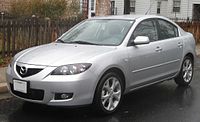
_Maxx_sedan_01.jpg)
_Maxx_Sport_hatchback_(2015-07-10)_02.jpg)
_Neo_hatchback_01.jpg)
_Maxx_Sport_sedan_(2011-03-10).jpg)
_SP23_hatchback_01.jpg)
_Maxx_Sport_hatchback_(2010-07-19).jpg)
_Maxx_hatchback_(2011-04-28).jpg)
_Neo_sedan_(2018-09-17)_02.jpg)
_SP20_SKYACTIV_sedan_(2018-10-01)_01.jpg)
_Neo_sedan_(2016-01-04)_02.jpg)
_SP25_hatchback_(2015-07-14)_02_(cropped).jpg)

_–_Frontansicht,_22._Mai_2011,_Düsseldorf.jpg)
_–_Heckansicht,_22._Mai_2011,_Düsseldorf.jpg)
_Maxx_hatchback_(2015-11-11)_02.jpg)
_2.0_SkyActiv_(CBU)_4-door_sedan_(19680560286).jpg)

